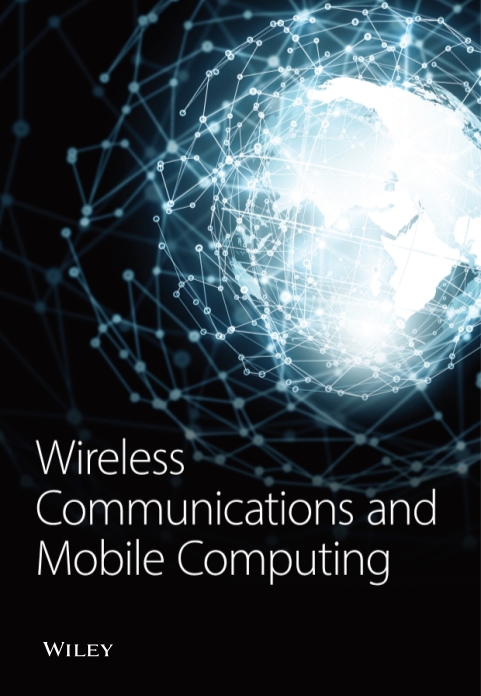Metaphor Recognition of English Learners Based on Machine Learning Algorithm
Abstract
The advantage of machine learning algorithm lies in predicting the semantic category of new language features according to the joint probability distribution of existing language features and their semantic categories. Based on a machine learning algorithm, this paper studies the metaphor recognition of English learners. The process of metaphor recognition is described as the classification of metaphorical meaning and literal meaning. Metaphor modeling is carried out by maximum entropy and naive Bayes. Check whether the sentences in the verification set contain the language rules in the knowledge base, and semantically identify the words in the sentences according to the annotations of the knowledge base. For sentences that do not meet the language rules of the knowledge base, the machine learning module is used for further verification and identification. Based on the comprehensive features of context words and parts of speech, the ideal window of maximum entropy recognition is determined, and then the left and right position features are introduced to improve the experimental effect. In the comparative experiments of the three models, this model has obvious advantages in English learners’ metaphor recognition. Its recognition accuracy is high, and it has certain practical value.
1. Introduction
English idioms are phrases or expressions with a fixed structure and meaning that are an important and inseparable part of the English language [1]. The implied meaning of most idioms, however, cannot be inferred from the single meaning or literal meaning of phrases because they are metaphorical. As a result, learning idioms has become a challenge [2]. Traditional English learning stifles language development, and metaphor, as a linguistic phenomenon, is the key to improving learners’ cognitive ability, thinking ability, and language application ability [3]. Understanding and processing metaphor has always been an interesting research topic in the cognitive study of metaphor. The study of English learners’ metaphor recognition can help us not only better understand metaphor but also better understand the language understanding mechanism and reveal the brain processing process of bilinguals [4]. Metaphor is a unique language use phenomenon as well as a cognitive phenomenon. It can be found in all aspects of language and thought, and it is one of the most significant issues in human language and thought [5]. The study of metaphor recognition provides a more in-depth and dynamic perspective for us to study natural language understanding. The research method of metaphor has changed from the method of constructing knowledge base based on rules at first to the method of machine learning based on statistics [6]. Although the accuracy of metaphor recognition has been improved, the research is mostly in the field of computational linguistics. Scholars focus on the optimization of statistical algorithms but pay little attention to the linguistic features of metaphor. There is still much room for improvement in the accuracy of metaphor recognition.
In linguistics, the term “metaphor” refers to a metaphor that does not include figurative words. Metaphor is when something is compared to something else that has a similar relationship with it [7]. Metaphor is, in fact, a common occurrence in all natural languages and an unavoidable problem in natural language processing. As a result, if the metaphor problem is not solved properly, it will become a bottleneck impeding the advancement of natural language processing and machine translation [8]. According to the Metaphor Career Model, the mechanism for processing conventional metaphors differs from that for processing novel metaphors: processing conventional metaphors necessitates the extraction of metaphor categories previously stored in the brain, whereas processing novel metaphors necessitates a comparison between two domains [9]. Traditional metaphors will become novel metaphors for foreign language learners if they are unfamiliar with them [10]. As a result, in order to understand, learners must frequently compare the characteristics of the source domain and the target domain in order to find similarities [11]. Exploring the inherent law of metaphor and studying automatic metaphor recognition will be a brand-new attempt for a computer to comprehend rhetorical language. To master English as a language, we must first comprehend the language’s cultural connotation and the way people think. Chinese learners can communicate effectively in English, express their thoughts and comprehend the cultural meaning of the language, but they must also integrate language learning with cultural context learning organically [12]. The study of English learners’ metaphor recognition helps us to reveal learners’ cognitive activities and cultural interactions in the process of second language acquisition, promote students’ foreign language thinking, cultivate their metaphorical ability and conceptual fluency, and thus improve the efficiency of foreign language teaching [13]. Over the years, studies by Chinese and foreign linguists have shown that metaphor is a universal language phenomenon and an indispensable part of language. Metaphor in everyday language can improve learners’ language application ability, cognitive ability, and thinking ability [14]. Based on a machine learning algorithm, this paper studies the method of metaphor recognition for English learners.
Metaphor has piqued the interest of academics in recent years as one of the most difficult problems in natural language processing. While understanding ambiguity is a difficult problem in natural language processing, we must also recognize that metaphor is a challenge in natural language comprehension [15]. The study of metaphor has a long history, but there is no universally accepted definition of the term. According to cognitive linguistics, metaphor is essentially a common cognitive phenomenon among humans. Metaphor can be said to pervade the entire process of language development [16]. People are fully capable of recognizing metaphors even if they are unaware of the similarities in meaning. Metaphor recognition is a kind of conditional reflection of the metaphor receiver’s basic language ability and common sense on semantic anomalies. This process does not need any form of similarity reasoning [17]. Metaphor recognition is separated from complex metaphor understanding. This paper introduces the machine learning method into the study of metaphor recognition for English learners. This paper introduces the definition of metaphor, summarizes the research findings of metaphor from cognitive perspective and corpus perspective, respectively, and finally focuses on metaphor research. On the basis of previous studies on metaphor, this paper puts forward the linguistic features that need to be considered when constructing the automatic recognition model of metaphor. Collocation, class connection, word combination, words and their inflectional forms, and other language features must be considered when building the model. The fitted coefficients are loaded for the language features that appeared in the training set. The module calculates the coefficient value of the new language features based on the probability distribution of the existing language features according to the maximum fan principle for language features that do not appear in the training set, that is, new language features in the test sample. The module then combines the linguistic characteristics of each dimension with the semantic category to which it belongs and predicts the semantic category with the highest probability of occurrence of the word in question.
2. Related Work
“Two cognitive structures are connected by nonliteral similarity,” according to the literature [18]. “Literal similarity” means that the compared things are visually consistent, whereas “nonliteral similarity” means that there is partial consistency between the two things, as determined by analogy and other means. The literature [19] established the basic framework of metaphor theory, but many key issues in metaphor research were not adequately explained. According to the literature [20], metaphor is a way for people to experience the world, think, and live, and it is the key to human language. The literature [21] regards metaphor components as atoms and complex metaphors as molecules, and the process of analyzing complex metaphors is called complex metaphor decomposition method. The literature [22] holds that the meaning of language not only comes from vocabulary and syntax itself but also depends on specific context. It can be said that the meaning of language is realized on the basis of context, and communication activities and speech acts can not be separated from specific context, which is an important factor in determining semantics. The literature [23] takes English body metaphor as the research object and, based on the analysis of the linguistic features of body metaphor, constructs an automatic recognition model of body metaphor, aiming at exploring the optimization way of automatic recognition of metaphor. The literature [24] puts forward a formal analysis method based on “Metaphor Role Dependence Pattern” in metaphor classification and recognition. On this basis, the computational classification system of language metaphor is constructed. The literature [25] introduced the machine learning method into the study of Chinese metaphor recognition.
On the basis of in-depth study of related literature, this paper takes metaphor recognition as the research content, starting with nominal metaphor and verbal metaphor, which are the two main types of metaphor, and using various machine learning algorithms, extensively discusses the methods of metaphor recognition. The model will load the fitted coefficients for language features that have already appeared in the training set when the machine learning module is used to identify the semantics of words in the verification set. The maximum entropy model will evenly distribute the probability of occurrence of semantic categories for features that do not appear in the training set and calculate the value of new language features based on the data distribution of existing language features for features that do not appear in the training set. In this paper, the algorithm. To improve metaphor recognition accuracy, information from both labeled and unlabeled samples is used. This paper has made a significant contribution to the study of metaphor for English learners, as well as laying the groundwork for future research and development of the metaphor calculation theory and model.
3. Methodology
3.1. A Probe into English Learners’ Metaphorical Cognitive Thinking
Traditional rhetoric holds that metaphor is a linguistic phenomenon, and its main function is to rhetorize the text. We know metaphor in poetry, painting, music, fairy tales, fables, drama, and other artistic fields. Metaphor is essentially a derivative phenomenon of rhetoric and language, which belongs to figures of speech [26]. Contemporary cognitive linguistics holds that metaphor is not only a universal linguistic phenomenon but also a fundamental way of thinking and cognition of human beings. Metaphor is a common metaphor in life, a vivid expression from life. Modern metaphor research in the west has broken through the boundary of rhetoric, recognizing that the essence of metaphor is cross-domain mapping in conceptual system, which is a form of language expression. The essence of metaphor is to understand or experience another thing with one thing. It is the basis of human organization conceptual system and experience and belongs to thinking rhetoric.
Metaphor appears when a discourse unit is used to refer to something, concept, process, character, relationship, or world that it cannot normally refer to or collocates with its discourse unit that it cannot normally collocate, and this unconventional referent and collocation behavior is understood on the basis of similarity or analogy involving at least the following two, namely, the conventional referent of the unit and the actual referent of the unit [27]. Metaphor, as the main topic of cognitive linguistics, is also experiencing this turn. Metaphor is a conceptual system, which consists of source domain and destination domain. Conceptual metaphor is a metaphorical expression that is stored in people’s minds and reflects the essence of things and reflects the mapping relationship between different conceptual domains.
In recent years, the study of metaphor has been deepening and developing. Metaphor is a cognitive phenomenon. Its essence and function have extensive and profound influence on human thinking mode, artistic creation, and language use. The study of modern metaphor theory determines the cognitive nature of metaphor, the definition of metaphor is expanded, and the phenomenon of metaphor is broader. With the academic understanding of metaphor rising from language level to cognitive thinking level, the understanding of metonymy has also undergone the same change. Metonymy is not only a rhetorical device in language but also a way of thinking. Metaphor in metonymy means that the whole known phrase is metonymic usage, but cross-conceptual mapping still occurs to form metaphor. The cognitive basis of conceptual metaphor is image schema [28]. Image schema is a dynamic representation of spatial relationship and movement, which has its internal logic or structure. These logics or structures determine their role in building other concepts. Schema comes from people’s embodied experience of things in daily life and plays an important role in cross-domain mapping.
The broad definition of metaphor defines the category of metaphor, but it is difficult to conduct accurate and formal computational research with such a definition because it is too abstract and broad. A more precise definition that can describe the formal and functional features of metaphor language is needed based on the definition of generalized metaphor category. In the process of learning English, students are exposed to a large number of language expressions that reflect metaphorical thinking patterns. Understanding the meaning of words, sentences, and paragraphs can be aided by mastering English metaphors. On a linguistic level, metaphorical thinking is reflected in metaphorical expression. At the linguistic level, metaphor recognition encounters a variety of metaphorical expressions. The knowledge of the metaphorical source concept field and the target concept field is required for metaphor comprehension at the cognitive level. These two levels must be distinguished and related in formal metaphor computing research. Figure 1 visually shows this difference and connection.
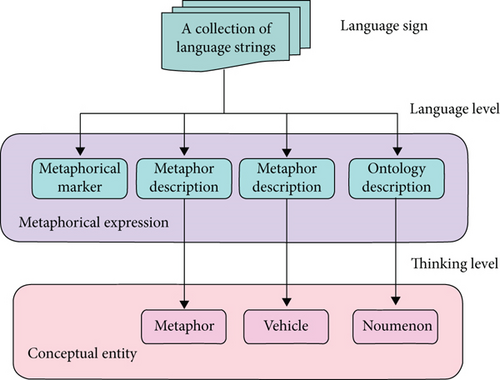
In traditional rhetoric, metaphor and simile are regarded as two juxtaposed figures of speech. In modern metaphor, simile expression and metaphor expression in “language” are triggered by the conceptual metaphor mechanism of cognitive hierarchy, and simile can be regarded as a kind of generalized metaphor. Conceptual metaphor has the characteristics of national culture. Conceptual metaphor is a way of human thinking and a cognitive process. And the human way of thinking is national. People’s cognitive activities and their own experiences are formed and developed in a specific culture and society, so the metaphorical conceptual system formed on this basis is also national and cultural, which will definitely bear the brand of a specific society and culture and reflect the concepts and characteristics of national morality and values. Therefore, conceptual metaphor is not only universal, but also special, reflecting the individual characteristics of specific culture and national thinking mode.
According to the degree of generalization and motivation of metaphor, it can be divided into two types: complex metaphor and basic metaphor. The mapping relationship between people’s sensory motor system and subjective experience is referred to as a basic metaphor. Complete metaphor processing starts with literal expression and looking for metaphorical expression at the linguistic form level, then identifying the ontology description, vehicle description, and metaphor description; then deducing the similarities of ontology, vehicle concept, and metaphor from the expression level through some transitional mechanism; and finally transferring to metaphorical concept mapping and metaphorical meaning acquisition at the cognitive level. Asymmetry is a feature of conceptual metaphor. The mapping process from the source domain to the destination domain helps us understand metaphor. The origin domain is frequently familiar, concrete, and vivid in this process; the destination domain is generally unfamiliar or abstract. The conceptual representation development model is shown in Figure 2.

Corpus-based metaphor research refers to “with the help of corpus retrieval and statistical tools, on the basis of analyzing a large number of language data in computer corpus, describing the surface language metaphor, and further summarizing the research on its inherent laws and patterns.” From the definition of metaphorical expression, a linguistic metaphorical unit includes four parts: ontology description, vehicle description, metaphor description, and metaphor marker. Previous studies on metaphor have focused on discussing metaphorical phenomena with clear structure and clear conceptual meaning. However, from our analysis, the metaphorical expressions with clear structure and clear reference only account for a very small part of the real metaphorical corpus. The expression of metaphor presents more complex features, which brings great challenges to the calculation and processing of metaphor. Corpus-based metaphor research mainly discusses metaphor phenomena in real context, trying to dig out the usage rules and functions of metaphor in real context.
The metaphor of creating similarity refers to the fact that there is no similarity between ontology and vehicle or the similarity is not known or familiar before people use the metaphor. From the perspective of structuralism, metaphor can not only be regarded as a language tool, but more importantly, we should recognize its essence, significance, and value as a basic thinking tool. Metaphor thinking reflects the structure and direction of people’s consciousness and spiritual activities. Metaphor exists in people’s language, thought, behavior, and other activities. Ontology, vehicle, and bottom, which are closely related to the understanding of metaphorical meaning, have a direct influence on the extraction of metaphorical concepts at the thinking level. However, such description can be performed by any linguistic unit.
3.2. Metaphor Recognition for English Learners Based on Machine Learning
Machine learning is the most popular topic in the field of artificial intelligence at present, and has achieved fruitful results. This study is also an attempt to use the concepts and methods of machine learning for reference in the field of metaphor recognition for English learners. A computational study of metaphor adopts statistical methods such as machine learning and uses large-scale corpus as data source to build a metaphor analysis model. More and more attention is paid to the application of linguistic research results in this field. Parameters are the core of machine learning, and training is the process of learning training set data and finding the best parameters. According to the mathematical algorithm that has been strictly deduced, the purpose of parameter optimization is achieved. The inspiration given to this model is to introduce the idea of training, which can make the model automatically adjust its parameters to fit the real adaptive relationship and make it a learning tool for dynamic modeling. Different from the research based on a clustering algorithm, the research based on a supervised machine learning method relies more on linguistic information. The concrete performance has two points. (1) When training the model, give a semantic category label to each sample in the sample set. (2) When building the model, apply the language information in semantic knowledge base.
Many metaphor researchers overlook the phenomenon of nesting and reusing linguistic metaphors. Nesting and progressive reuse of metaphors are very common in actual research, and it has become a problem that cannot be overlooked in the study of metaphor understanding. The syntactic types corresponding to different collocation structures are slightly different, and the metaphorical collocation structure defined in this paper primarily serves the construction of an automatic metaphor recognition model. The collocation structure, as defined in this paper, is a structure type with low semantic separability, little change in syntax and morphology, and a high degree of semantic solidification; it expresses unique semantics and does not change with changes in the surrounding context.
Metaphor, as a universal linguistic phenomenon, has various forms of expression, and different structures and semantic relationships play an important role in the excavation of metaphorical meaning. Establishing a unified formal analysis method of metaphor expression at language level is the first difficult problem to be solved in metaphor calculation. The manually constructed semantic knowledge base can accomplish many tasks: metaphorical meaning identification and semantic interpretation, and the identified metaphorical meaning includes not only conventional metaphors but also new metaphorical usage. However, when the semantic knowledge base is used to complete the identification task, the words to be identified must be the existing words in the tagging system. Learners’ comprehension strategies are ranked according to the frequency of use, followed by sentence context, literal translation, known English knowledge, Chinese knowledge, random guessing, mental image, and syntactic analysis. Among them, the two strategies of sentence context and literal translation account for a relatively high proportion, which shows that learners mainly rely on language knowledge, followed by strategies of using background knowledge, including mother tongue and English background knowledge. For sentences not covered by the knowledge base module, extract effective language features that can distinguish literal meaning and metaphorical meaning of human words. After repeated experiments, it is found that the language features under this category mainly include words and their positions, parts of speech and their positions, word combinations, and abstract values of words. In this paper, the modules built according to the above language features are defined as machine learning modules.
The diversity of the description forms of the main components of metaphor at the expression level will inevitably lead to the low repetition rate of the values, thus making it impossible to operate the method of establishing dictionaries or corpora of ontology, vehicles, and metaphors according to the traditional natural language processing technology. This is one of the issues that must be considered in the study of metaphorical language surface analysis and the transformation from surface to concept. The purpose of the rule-based method is to aid in the completion of the task of automatic metaphor recognition by creating a knowledge base. Automatic metaphor recognition research in the field of computational linguistics primarily is aimed at identifying linguistic metaphors, with a few studies aimed at identifying conceptual metaphors. In the study of automatic metaphor recognition based on statistics, two main statistical methods are used: supervised machine learning and clustering methods. Giving category marks to each input sample in the training sample set is referred to as supervised machine learning. When each input sample in the training sample set does not give a category label, the clustering algorithm, also known as unsupervised machine learning, automatically clusters the input samples.
Language features are an important guarantee that affects the machine learning model’s recognition effect, and the model’s recognition effect is good, proving that the language features chosen are effective language features. Words and their positions, parts of speech and their positions, abstract values of words, word combinations, and so on are the main types of language features chosen in this paper. With the exception of metaphorical markers, every linguistic metaphorical component can be described by a single word, a phrase, a sentence, or even a discourse. If the ontology, vehicle, or bottom of metaphor are each considered mathematical variables, the value set of these variables will be an infinite set with no formal rules. The grammatical structure of words determines the linguistic expression range of literal and metaphorical meaning of words, which is closely related to the semantic structure. When building an automatic metaphor recognition model, the language expression range can be used as the extraction range of language features.
Successive-progressive reuse of metaphor means that in a metaphor, a metaphor appears in front of it as a presupposition, followed by another metaphor, which describes the previous metaphor step by step or exists alone as a derivative metaphor of the previous metaphor. The phenomenon of progressive reuse of metaphor is more common among metaphors of complex sentence patterns. The combination of language knowledge and statistical algorithms is the development direction of metaphor automatic recognition research. However, at present, the research in this field mostly stays in the stage of language hypothesis verification or small-scale experiment, and language knowledge is not well integrated with statistical algorithms. In order to build a robust automatic metaphor recognition system, the application of language knowledge should be strengthened in the field of natural language processing. The calculation of metaphor should consider two levels of language form and thinking and reasoning and fully handle the differences and connections between the two levels. The complexity of language expression, the uncertainty of description of main components of metaphor expression, the uncertainty of the presence or absence of each component of metaphor, and the universality of metaphor nesting and progressive reuse are the main difficulties of metaphor formalization, which actually comes from the subjective creativity of metaphor users.
4. Result Analysis and Discussion
Teachers pay attention to explaining the connotative meaning and metaphorical meaning of vocabulary in teaching. By metaphorically developing and extending a word from the central meaning to other meanings, the original word is given a new part of speech, and the noun becomes a verb, with more and richer meanings, which constitutes polysemy. The polysemous words should be traced back to the source, get to the bottom of it, and grasp it in a comprehensible way. Metaphor is to understand or experience abstract things or experiences with concrete things or experiences and map the schema structure of the source domain to the target domain in some way, so that we can construct and understand the target domain through the structure of the source domain. Association is the fundamental way to realize metaphorical meaning, based on finding similarities between things. Learners compare things by imagining Cain’s pictures in their brains, find similarities, and then understand the content to be expressed in the source domain. In the verification stage of the model, we mainly use the text in the verification set, and we need to use the built model to identify the semantics of human words in the verification set and then compare it with the semantics of manual annotation to get the final recognition result.
Learners mainly use contextual knowledge and literal translation strategies, followed by English cultural knowledge and Chinese cultural knowledge. In addition, learners also use the strategies of guessing, mental image, and syntactic analysis to understand metaphor. And semantic contexts are interdependent and interactive processes. Simplify the meaning of context; context concretizes meaning; make words acquire rhetorical meaning by context; context makes words and sentences acquire temporary meaning; context enables words to acquire social and cultural meaning. Context has the function of restricting and explaining semantics. The process of language communication is always influenced by one or another, one or more contexts. The automatic metaphor recognition model constructed in this study is divided into two submodules: rule-based knowledge base module and machine learning module. According to linguistic knowledge, we can optimize the selection of features to improve the recognition effect of the model. We counted the comprehension strategies related to the correct answers and compared them with the general strategies, as shown in Figure 3.
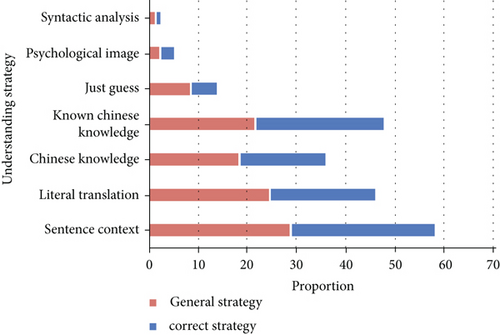
It can be seen from the figure that the order of frequency is as follows: sentence context, known English knowledge, literal translation, Chinese knowledge, guessing casually, psychological image, and syntactic analysis. Compared with the total strategy frequency, the ranking has changed slightly. Context still ranks first, but literal translation has dropped from the second place to the third place in the overall strategy, while known English knowledge has risen from the third place to the second place in the overall strategy. Random guessing, mental image, and syntactic analysis are still in that order. Metaphor is the foundation of human cognition, thinking, speech, and behavior. To truly master the target language, we must consider its implied meaning, deeply understand the target language’s social culture and language culture, and understand the metaphorical meaning of language at the cognitive level. The metaphorical corpus in this test includes not only some idioms with conceptual metaphor foundations but also words and phrases with metaphorical meaning. Furthermore, this test requires students to write down their psychological activities without talking to one another or asking for metaphor-related information. Therefore, in our research, there are no strategies such as analyzing metaphor, asking for additional information and repeating metaphor. On the contrary, the chances of using other strategies, such as background knowledge and grammar analysis, will increase. Figure 4 is an average graph of English major and non-English major learners’ strategy use.
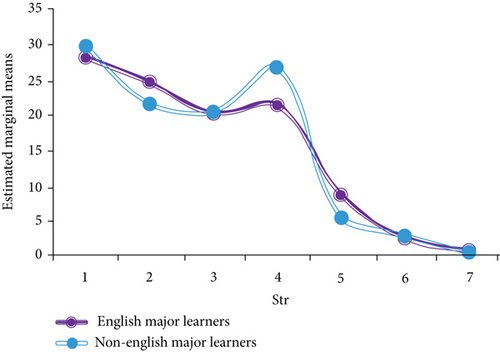
According to the descriptive statistics of metaphor comprehension strategies used by the two groups of subjects, the average score of English majors is higher than that of non-English majors in using sentence context, literal translation, and known English knowledge strategies. In language, conceptual metaphor helps to construct discourse coherence, and metaphor runs through the whole discourse. Metaphor has the function of coherence, which determines that we can generate coherent discourse. When we organize a discourse, we may organize sentences with one or several conceptual metaphors as reference points, and this one or these conceptual metaphors can become the mental basis of discourse coherence. No matter whether the target idioms appear in metaphorical context or whether their metaphorical meaning is familiar to the subjects, for the subjects, understanding foreign idioms must go through a necessary process of literal meaning processing; that is, literal meaning has processing advantage effect.
In order to get a stable fitness, the solution process of the model refers to the adaptive test based on item response theory, which is similar and different. Similarities are that all parameters can be updated according to the user’s response mode, and the timing of parameter update is recalculated immediately after learners finish learning a project, and the operation process is similar. There are two differences: the operation formula used in the model is the formula of AdaBoost algorithm. The standard deviation of each fitness of the last three times is used to determine the end of the model. The adaptability of learners with different cognitive characteristics to learning content is called adaptability; that is, adaptability is used to indicate the adaptability of learners with certain cognitive characteristics to certain learning content. In order to verify the effectiveness of this model, we carry out experiments on traditional metaphor recognition methods, metaphor recognition methods with semantic knowledge, and metaphor recognition methods in this paper. The accuracy of the three methods is shown in Figure 5. The recall rates of the three methods are shown in Figure 6.
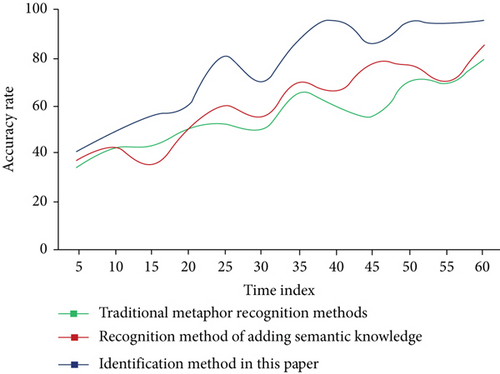
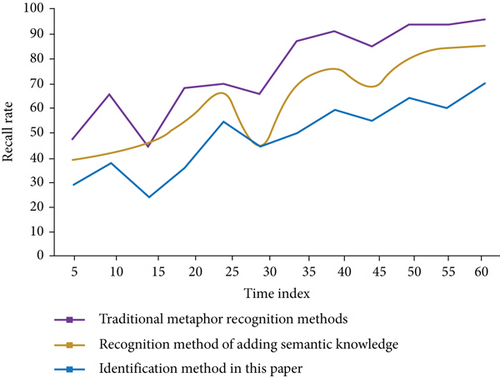
As can be seen from the above figure, from the overall verification results, the model constructed in this study has the best recognition effect. And the recall rate is slightly higher than the other two models. The corpus for this study was chosen at random from the corpus, and the types of metaphors were manually marked, ensuring the model’s applicability to some extent. The knowledge base consists of an induction and summary of the artificial metaphor annotation text’s language rules. The following are the criteria for selecting language rules for inclusion in the knowledge base: The structure of language expressions has been established, and the meaning of each expression is distinct. That is to say, the word structure’s collocation intensity is high, and the semantics of expression will not change as the surrounding context changes. A prototype system based on the model was developed and tested in order to further prove the model’s validity and practical application value. A server and a client make up the prototype system. The server is in charge of updating the subjects’ fitness using the model’s algorithm. The client is in charge of presenting various types of learning materials for the subjects to select from. The participants in this study, regardless of their English language proficiency, tended to understand English metaphors by using the context of sentences and the literal meaning of words, confirming the “context effect theory” and “literal meaning salience hypothesis” in foreign language learners’ metaphor understanding. The background of the two groups of participants in this study is similar. To verify the superiority of this model, compare the accuracy of metaphor recognition among three methods, and the comparison results are shown in Figure 7.
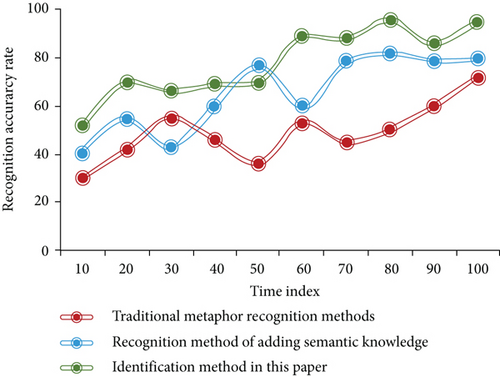
It can be seen from the figure that the accuracy rate of metaphor recognition of this model is higher than that of the other two models. The recognition accuracy of this model is high, and it has certain use value. The characteristic of a good model recognition system is that it can clearly and naturally reveal the structural relationship among the constituent elements. The eigenvalues of different samples from the same category should be very close, while the eigenvalues of samples from different categories should be very different. That is, the extracted language features must be distinctive features. Specifically, the machine learning model requires language features to be representative features, which requires strict definition of the selection range of language features, that is, the span of the left and right contexts of the target vocabulary. This paper identifies metaphorical collocations in verb phrases, which contain too little contextual information, only verbs and collocations, and their parts of speech, so the experimental results are not satisfactory. At the same time, the number and characteristics of training corpus in the experiment also affect the effect of the experiment.
With the improvement of foreign language learners’ language proficiency, learners reorganize the original concepts. The connection strength between foreign language words and concepts has been strengthened. The relationship between the unique metaphorical conceptual elements of the second language and the shared concept began to strengthen. The probability of positive migration increases, and the probability of negative migration decreases. Metaphorical language expressions derived from concepts are various, which make language expressions more vivid and natural and learners’ thinking more innovative and broader. It is worth pointing out that although learners tend to understand literally, literal meaning does not always lead to correct interpretation. Through the research in this chapter, it is concluded that the overall recognition accuracy and recall rate of this model are higher, and the recognition effect is better than the previous automatic metaphor recognition models.
5. Conclusions
Deep thinking is an important tool for English learners who want to grasp the true meaning of words. Language’s primary function is communication, and the goal of language study is to improve communicative skills. To understand metaphor, Chinese English learners primarily employ sentence context and literal translation strategies; second, they employ existing English background knowledge and Chinese cultural knowledge; and finally, they employ random guessing, mental imagery, and syntactic analysis. As a result, English-speaking monolinguals’ metaphorical understanding model is not entirely appropriate for Chinese-speaking English learners. This study builds a metaphor recognition model for English learners using a machine learning algorithm based on an analysis of semantic distribution and language expression of metaphor. For many experiments, specify the number of words and parts of speech that come before and after the target word. The maximum entropy method has a high accuracy and recall rate when used in an open test. Finally, the experimental effect is improved by using the auxiliary features of left and right position information. The metaphorical role framework is defined to express the literal semantics of metaphorical sentences, and the metaphorical meaning acquisition mechanism driven by the attribute of the target concept is used to complete the inference and generation of metaphorical meaning, resulting in the metaphorical transformed meaning. The interpretation rules of metaphorical meaning are presented, and the expression output of the true meaning of metaphor is constructed using metaphorical transferred meaning. This model aspires to be applied to related research on English learners’ metaphor, but it can also be easily transferred to other learning studies, with high reliability and robustness.
Conflicts of Interest
The author does not have any possible conflicts of interest.
Open Research
Data Availability
The data used to support the findings of this study are included within the article.



